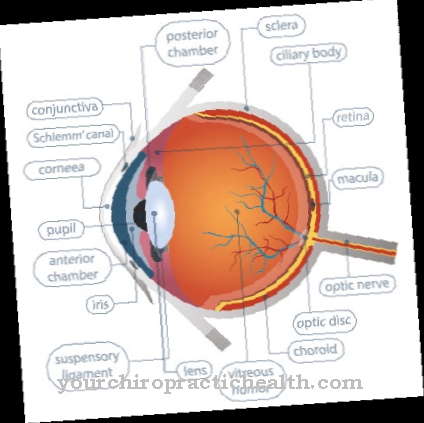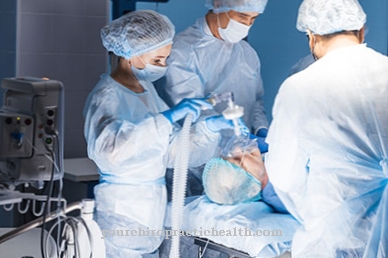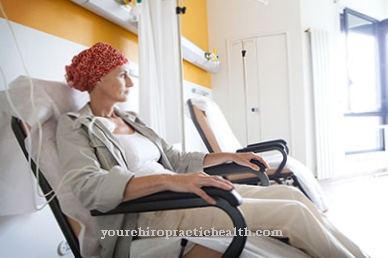As Epiphyseal capitis femoris is an orthopedic disease of the hip. She is also called Adolescent femoral head solutionknown.
What is epiphyseal capitis femoris?

© peterschreiber.media - stock.adobe.com
In the case of epiphyseal capitis femoris (ECF) it comes to the detachment and sliding of the femoral neck head within the femoral neck growth joint. Since the disease always shows up in childhood, it also bears the name Adolescent femoral head solution or juvenile epiphyseal solution.
Children between the ages of 10 and 14 are particularly affected by epiphyseal capitis femoris. The ECF is three times more common in boys than in girls. Many of the sick children are overweight. An acute course of the hip joint disease is rarely seen, so that it usually takes a chronic course. In half of all cases there is a detachment of the femoral neck head on both sides of the body.
Doctors differentiate between three forms of epiphyseal capitis femoris: threatening, sudden and creeping ECF. With the threatening form, the epiphyseal loosening only begins. An X-ray examination only shows a loosened epiphyseal plate. The acute form, which occurs suddenly, is rare. The growth plate comes off completely. Most affected children suffer from creeping ECF, in which the femoral head gradually slides off the femur.
causes
The exact cause of the epiphyseal capitis femoris has not yet been found. The epiphyseal detachment is rarely triggered by an accident. However, most children are either overweight or tall. For this reason, many doctors suspect hormonal disorders as the origin of the ECF. Growth hormones have a higher proportion than sex hormones.
As a result of the epiphyseal capitis femoris, the epiphyseal plate becomes completely detached. Since this creates a connection between the femoral neck and femoral head, this leads to an impairment of the femoral head blood supply. This increases the risk of the femoral head dying off. While the femoral neck slips off, the femoral head itself remains in the acetabulum.
You can find your medication here
➔ Medicines for painSymptoms, ailments & signs
Typical symptoms of femoral head epiphysis include pain in the knee. These show up in the knee joint region or on the front of the thigh. The pain, which is rather minor, can also occur in the groin. Sometimes there is also a slight shortening of the legs and a limp in the hip. If the hip joint is flexed, internal rotation (inward rotation) is restricted.
If there is an epiphyseal solution on both sides of the body, the so-called scissors phenomenon occurs. This means that the lower legs cross each other when the knees are bent. If the acute ECF occurs, the affected children suffer from considerable pain and sudden onset of restricted mobility. In most cases, an accident is responsible.
If the blood vessels are severed due to the femoral head slipping, there is a risk of femoral head necrosis, in which the hip tissue dies. In addition, the cartilage tissue can perish, which in turn leads to a considerable loss of mobility. In both cases there is premature wear and tear on the joints, which has very negative effects on children.
diagnosis
Diagnosing epiphyseal capitis femoris is not always easy. The reason for this is the fact that the pain in the knee area often cannot be distinguished from other complaints of this type. It is not uncommon for the ECF to remain undiscovered for some time. Only at a later stage can indications of the epiphyseal detachment be found.
An X-ray examination is one of the diagnostic measures. In this way, a more precise assessment of the slip status is possible. For the examination, the patient has to bend the hips 70 degrees and spread them 50 degrees. The second hip joint should also be examined to determine whether the epiphysis is detaching on either side of the body.
Magnetic resonance imaging (MRI) is sometimes used to confirm the diagnosis. If the ECF is treated in good time, it usually takes a positive course. In this way, the disease can heal without malpositions. However, if a malposition occurs, there is a risk of hip joint wear and tear.
Complications
The epiphyseal capitis femoris causes severe pain in the knees in most cases. These can take the form of pain at rest or pain under stress. As a rule, this restricts the patient's everyday movement, which is also increased by the shortening of the legs.
Pain can also occur in the groin and reduce the quality of life. In the worst case, blood vessels can be severed, which leads to severe restrictions on movement. Especially children are severely affected by epiphyseal capitis femoris, as it can lead to consequential damage in adulthood.
In most cases, a causal treatment of the epiphyseal capitis femoris is performed. Acute pain and symptoms can be limited by therapy. However, the person affected must take care of their joints and body and must not carry out any extraordinary loads.
If the bone slips off, surgery is usually necessary. Various fixing elements can also be attached to the knee in order to allow a load. After that, in most cases there are no further complications. However, the risk is increased that the epiphyseal capitis femoris also occurs on the second knee.
When should you go to the doctor?
If growth disorders are noticed, a doctor should be consulted. If there are irregularities in the hip region, it is advisable to have these clarified by a doctor. If changes in locomotion are noticed after an accident, these must be examined and treated as soon as possible. Medical care is necessary in the event of restricted mobility, bone changes or pain. If you experience unsteadiness, coordination problems or hobbling, this is cause for concern.
The general risk of accidents increases and well-being is significantly impaired. If the body is tilted, have it examined by a doctor, as permanent impairments can occur. If you experience muscle discomfort, stiffness or tension, a doctor is required. Headaches, emotional stress, or psychological problems should also be discussed with a doctor.
If sleep problems, difficulty concentrating, attention deficit or a noticeable change in mood occur over a long period of time, these symptoms should be reported to a doctor. Before taking any medication, it is advisable to consult a doctor to clarify possible side effects and risks. If sharp pain occurs during the movement, this is considered extremely unusual. If normal physical activities can no longer be performed, a doctor's visit is necessary. If bruises or discoloration of the skin repeatedly form in the hip region, they should be presented to a doctor.
Doctors & therapists in your area
Treatment & Therapy
The treatment of epiphyseal capitis femoris should be carried out by an experienced pediatric orthopedist. The therapy depends on the particular form of the disease. If it is an acute form of ECF, no further stress on the hip may be applied. If the shift is only slight, conservative treatment is sometimes sufficient. This is done by continuously pulling the affected leg.
However, if there is a significant displacement, surgery usually needs to be performed. It is not uncommon for the slipping to result in a bruise (hematoma), which is also treated as part of the procedure. After the reduction, the surgeon fixes the femoral head again. In most cases, surgical treatment is carried out with screws or wire pins. If there is a larger glide angle, a femoral neck correction osteotomy is often performed.
During the operation it is also possible to prophylactically fix the second side of the femoral head with screws to prevent it from slipping. This is considered important because the risk of epiphyseal capitis femoris also occurring on the other side is between 16 and 60 percent. The danger is particularly great for girls. However, a preventive intervention is not without controversy among medical professionals. It is important to start therapy as early as possible.
Outlook & forecast
With epiphyseal capitis femoris, the decisive factor for the prognosis and the course of the disease is the time that elapses before a diagnosis and subsequent treatment. The less time passes, the better the chances of recovery for the affected children.
Especially in the acute form with a sudden slipping of the femoral head, therapy must be carried out quickly and can thus prevent serious long-term consequences. Other factors that determine the course of an femoral head solution include how suddenly the femoral head slips (acute or chronic form), the angle at which the head slips to the shaft and which therapy method was used.
The death of the femoral head, the so-called femoral head necrosis, occurs due to insufficient supply of the head. It is probably the most serious complication of epiphyseal capitis femoris. In many cases, however, this can be prevented by an early operation.
Other consequential damage to epiphyseal capitis femoris include osteoarthritis that occurs at a young age, misalignments in the hip joint and associated complaints such as restricted mobility and pain in the affected hip. If the disease is diagnosed in good time and the hip joint can be operated on without a subsequent malposition, the prognosis of the femoral head solution is good nowadays.
You can find your medication here
➔ Medicines for painprevention
There are only a few special preventive measures against epiphyseal capitis femoris. So it is recommended to avoid obesity and physical overload.
Aftercare
In most cases, those affected with epiphyseolysis capitis femoris have no special follow-up options available. Therefore, the patient is primarily dependent on a medical examination and treatment of this disease in order to prevent further symptoms. If left untreated, it cannot heal itself, and the symptoms usually worsen.
The treatment of epiphyseal capitis femoris usually takes place with the help of surgical interventions. After such procedures, the patient should rest as much as possible and not unnecessarily strain his body. Above all, stressful or sporting activities should be avoided, whereby the person concerned should ensure strict bed rest.
Furthermore, physiotherapy measures often have a positive effect on the course of the epiphyseolysis capitis femoris, whereby many of the exercises can also be performed in your own home. Even after a successful treatment, regular examinations by a doctor are very useful.
In some cases, several surgical procedures are necessary. Loving care and support for the patient has a positive effect and can possibly alleviate psychological complaints. As a rule, epiphyseal capitis femoris does not reduce the life expectancy of the person affected.
You can do that yourself
In everyday life, care should be taken to maintain a normal weight. With a healthy and balanced diet, the patient's weight can be reduced. The BMI can be calculated independently and provides information about the ideal weight range in every age. As a support, it is advisable to encourage adequate exercise in addition to nutritional control. Sports activities support well-being and help you lose weight.
In all physical activities, excessive stress on the bones should be avoided.In particular, the hip area should be protected from overuse. In addition, one-sided postures and incorrect loads are to be avoided. Training for a healthy sitting position or training for good posture in all situations help. Balancing movements and practicing sports that are considered to be particularly gentle are helpful.
If there is pain in the hip or knee, adequate rest and rest should be initiated. The joints are to be protected from stress and should be cooled immediately when symptoms occur. Knee pads or bandages can be put on before sporting activities. This gives the knee additional stability in all movements. Natural healing products can be applied directly to the skin to relieve pain. We recommend using products that contain arnica or aloe vera.


.jpg)






















.jpg)

.jpg)
